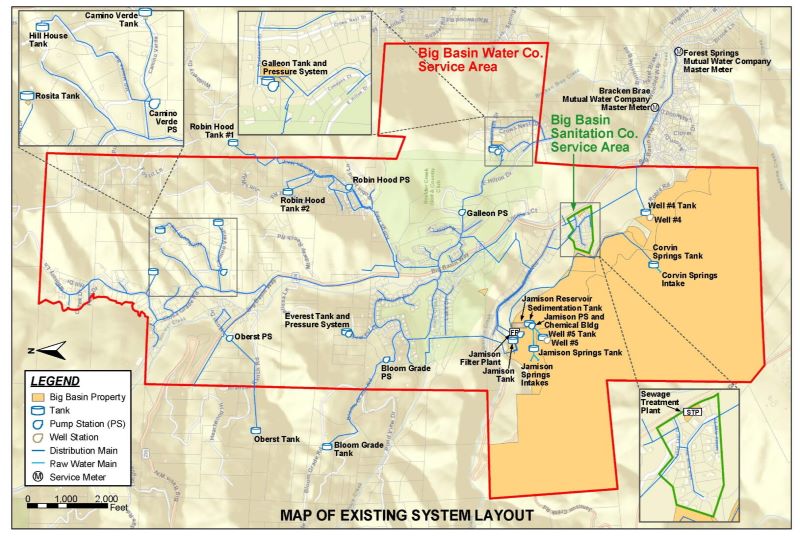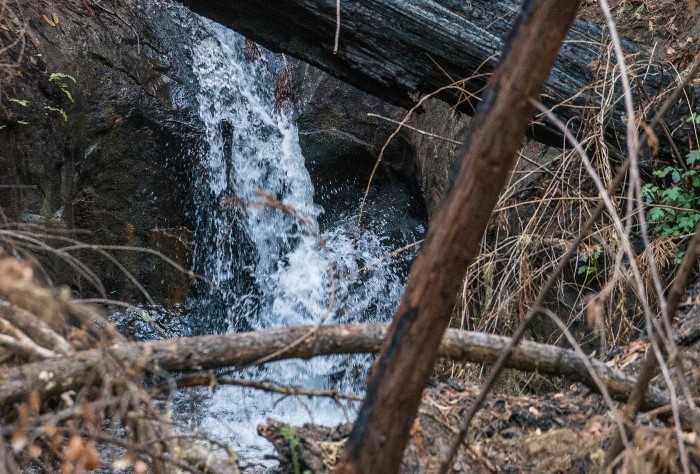New Developments for Big Basin Water Company Customers
By Mark Dolson
Big Basin Water Company (BBWC) customers have been rocked in recent weeks by two dramatic developments in their years-long quest for a more reliable supply of water: (1) consolidation discussions between BBWC and the San Lorenzo Valley Water District (SLVWD) have been halted, and (2) the State of California is moving to place BBWC’s water system into receivership. Underlying these latest developments is a multifaceted story with important broader themes and contrasting perspectives that are relevant to our entire community.
BBWC is a small private water company located northwest of Boulder Creek. It has historically provided water to roughly 600 customers and wastewater service to around 30 customers. The company has been owned and operated for many years by the Moore family, and it has long been praised for the quality of its water, for the good intentions of its owners, and for its low water rates. Unfortunately, it is now widely agreed that these rates were excessively low, and that this has led to a host of problems. There are differing views, though, regarding the State of California’s role in this and on the road ahead.

The State recognizes reliable access to safe and affordable water as a human right, and it has a responsibility to protect this right for all residents. This is made more challenging by climate change and the many hundreds of public and private water providers scattered across California. The State’s response has been to actively promote consolidation of water suppliers and to entrust its Water Resources Control Board with ensuring that each individual utility is fulfilling the State’s commitment to reliable access and acceptable quality. In tandem, for private utilities like BBWC, the State’s Public Utilities Commission (PUC) is responsible for approving appropriate rates.
Over the past decade, due to the cumulative effects of BBWC’s insufficient revenue, the company has found it increasingly difficult to meet the standards set by the Control Board and the requirements of the PUC. This has created a vicious cycle in which BBWC has not adequately pursued PUC authorization for rate increases, and in which the company’s inadequate resources have led to multiple violation notifications — many relating to insufficient reliability and consequent outages and boil notices — from the Control Board. The company has experienced many of the State’s demands as unhelpful intrusions whereas the State has experienced the company as increasingly problematic. The situation reached a crisis point following the destruction of essential, and insufficiently insured, BBWC infrastructure in the August 2020 CZU Fire.
Today, BBWC continues to provide water and sewer service, but its water comes exclusively from groundwater pumping of a single low-productivity well, and its interim wastewater treatment strategy relies solely upon periodic pumping of accumulated waste. The company is staffed entirely by the three members of the Moore family, who have neither sufficient time nor financial resources to meet the current expectations of customers and the Control Board. The family believes that all problems will be solved if the PUC approves a substantial rate increase that adequately reflects operating costs, and if the company is sold to a new owner capable of making the investments in infrastructure that are needed to bring the system up to current State standards.
The family was pursuing a possible sale prior to the CZU Fire, but the resulting damage dramatically increased the necessary infrastructure investment. The family now says it hopes to conclude a sale to a new owner by the end of summer. However, local and State officials with water management expertise are less optimistic about the potential for a sale, and they note that a key open issue concerns the (still unknown) total amount of required infrastructure investment (because this expenditure would ultimately need to be recovered from customers).
These officials have long assumed that the obvious solution would be for BBWC to be consolidated into SLVWD. With roughly 8000 customers, SLVWD is comparatively large and well-run, and it has successfully managed many consolidations over the years. SLVWD would not assume responsibility for BBWC’s sewer service, but Santa Cruz County provides some sewer service around Boulder Creek, and it would be a logical candidate if adequate State funding could be identified for necessary repairs.
It is also worth noting that SLVWD is already moving to consolidate with Bracken Brae and Forest Springs, two very small and similarly fire-damaged public water systems adjacent to BBWC. The State of California is making money available for SLVWD to connect with Bracken Brae and Forest Springs. In parallel, Bracken Brae is receiving Federal Emergency Management Agency (FEMA) funding to support its own rebuilding. Forest Springs missed the FEMA application deadline, and BBWC, as a private company, is ineligible for FEMA funding.
SLVWD began actively exploring a possible consolidation with BBWC in November 2021, and it engaged in numerous meetings that involved the company, Water Board officials, and others. However, lack of progress led the SLVWD Board to unanimously vote on February 16, 2023 to suspend these efforts. SLVWD indicated that it still wanted to be a good neighbor (for example, SLVWD provided emergency response in repairing the BBWC distribution system, and it also installed a potable water filling station for BBWC customers facing a system-wide boil notice during storm events), but it estimated that the cost to operate the BBWC system would be about $30,000 per month greater than BBWC’s current rate structure would support.
In addition, SLVWD estimated that roughly $40 million in capital improvements and repairs would be required to bring the BBWC system to an acceptable operating state. The State indicated that it couldn’t provide this money to a private company, but it would likely help to cover this cost for a public district if a sufficient agreement were in place. Unfortunately, SLVWD has learned from experience that consolidations can prove more costly than anticipated, and it was unable to obtain adequate assurance that its existing customer base would not ultimately be required to absorb some of the costs associated with restoring BBWC infrastructure.
The SLVWD’s February announcement essentially returned BBWC customers to square one. If the $40 million estimate is accurate (and the Moore family doubts that it is), then a sale would seem unlikely. At the same time, the State’s oversight of BBWC to date has failed to produce substantial improvements. The State has imposed some fines, but these don’t address the deeper question of how the company could operate differently.
In desperation, and over the course of two years, BBWC customers have been reaching out to elected representatives and the Control Board. While the County has no jurisdiction over BBWC, Supervisor McPherson said in a recent statement that his office had begun working behind the scenes to escalate State attention to this situation. This effort culminated in the second dramatic development when the Supervisor’s office announced on March 17th that the Control Board was moving to place the water distribution portion of BBWC in receivership, meaning that an independent manager would become responsible for key decision-making. The Moore family can either accept this development or contest it in court, and it has not yet decided how to proceed. A receiver could conceivably reopen the door to discussions with SLVWD.
What will happen next remains to be seen, but two things seem clear. First, unrealistically low water rates ultimately work to the detriment of all, and approval of the proposed rate increase (a public hearing will be held on April 3rd) is a vital next step in any solution. Second, the State is finally assuming more active responsibility for a situation that nobody has been happy with; however, the underlying problems will still be challenging to resolve.
Mark Dolson is a member of the local citizens’ group Friends of San Lorenzo Valley Water (FSLVW), but he is writing here as a private citizen. FSLVW articles, initiatives, and Board meeting summaries are available online at friendsofsanlorenzovalleywater.org.
Featured Photo of Big Basin Creek by SLV Steve
Additional Information
The San Lorenzo Valley Post is your essential guide to life in the Santa Cruz Mountains. We're dedicated to delivering the latest news, events, and stories that matter to our community. From local government to schools, from environmental issues to the arts, we're committed to providing comprehensive and unbiased coverage. We believe in the power of community journalism and strive to be a platform for diverse voices.





